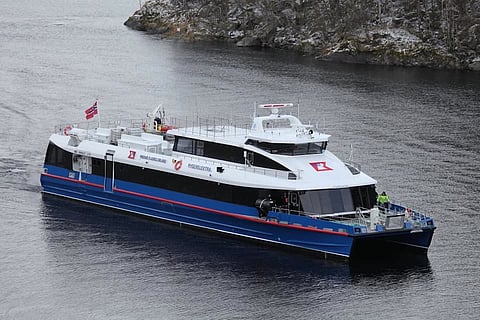

"No electric passenger ferry goes so far, so fast," said Rygerelektra's proud owner, Anders Rodre. He has every right to be proud of his new ferry, which is a showcase of the latest Norwegian –particularly its builder's – technology.
That technology is facilitated by Norway's good fortune in having almost all of its electricity hydro-generated, so their electric power really is clean. Even better for the owner, the Norwegian Government donated US$3 million to the project by providing practical re-charging facilities.
The vessel's world-renowned builder and designer, Brødrene Aa ("Aa Brothers"), which is probably the leading large carbon fibre shipbuilder on the planet, has produced a light, stylish and incredibly efficient tourist ferry.
Whoever would have thought that a 300-passenger ferry can operate most of the day at 20 knots? Of course, the technology involved to achieve this performance is mind-boggling.
The keys are very light but strong construction; low water and wind resistance; super-efficient controllable pitch propellers; and, the world's largest battery system totalling 2,100 kWh. All this adds up to a very impressive saving of 270,000 litres of expensive Norwegian diesel each year.
It is no wonder Rygerelektra was chosen as our Best Electric Ferry for 2020.
"The vessel represents a new, ground-breaking step within zero emission passenger transport," Brødrene Aa CEO Tor Øyvin Aa told Baird Maritime. "The carbon fibre catamaran is equipped with an all-electric energy storage and propulsion system. With her 2MWh battery installation, Rygerelektra also boasts the largest battery pack installed on high-speed vessels we have delivered to date."
Built in accordance with the high speed code, the ferry reached over 23 knots of speed during testing. However, as it is tailored to sightseeing operations, the lounge-style seat configuration has resulted in speed limitations. This resulted in the vessel downgraded to a maximum speed of 19.9 knots upon delivery.
"Fully loaded," added Aa, "she will have an operational range of approximately 40 nautical miles at 18 knots, using 70 per cent of the battery capacity between each charging. Reducing the speed to 17 knots increases the range to 50 nautical miles."
The decision to equip Rygerelektra with all-electric propulsion was made after both the customer and the builder recognised the increasing importance of sustainability in shipbuilding.
"There has been a growing global focus on climate change and sustainability," Aa remarked. "This will continue to affect politics, regulations, people and the markets in general, especially as governments globally are committing stronger to carbon neutrality. Demand for low- and zero-emission solutions is already here, and this demand will continue to compel builders of all types of vessels to be more mindful of energy efficiency and consumption."
The company added that the need to be more carbon-neutral will mean the introduction of stricter regulatory requirements. To cope with new requirements, there will be a need for improved systems and work processes, so as to provide necessary documentation and traceability. This, however, will also impact suppliers.
Aa commented that digitalisation will also make significant advances but cost efficiency will also need to be guaranteed at all stages of production from design to delivery.
Like many shipbuilders, Brødrene Aa was forced to adjust operations as Covid-19 swept across the globe.
"As we are in an industry characterised by long lead times," Aa told Baird Maritime, "the pandemic has affected us in a slightly offset manner compared to other industries and businesses. We started 2020 with a rather satisfactory order book and as the pandemic hit us, our focus was to keep production up and adjust to the new normal. Regulations and measures, and our own risk mitigation have naturally affected our production schedule, but we managed to deliver Rygerelektra with only a slight delay."
Aa further claimed that a more long-term effect of the pandemic was that sales processes had to be put on hold, leaving the company with excess capacity. Fortunately, as operators are starting to plan for a post-Covid environment, the builder has begun seeing strong interest from the market.
"Because of this interest," Aa added, "we remain highly optimistic of the opportunities ahead."
When asked what other trends will shape the passenger vessel industry over the coming years, Aa commented that energy efficiency and environmental impact will be among the most noteworthy.
"We will see new hull and foil concepts emerge, paired with new and improved propulsion solutions, with the aim of increasing energy efficiency, while energy storage will shift to technologies enabling zero emission operation such as batteries, hydrogen, ammonia, etc.
"Market wise we see opportunities emerge in several segments, but most importantly, we see the new environmental requirements as a strong driver for replacement or rebuild of older vessels. As new technology gradually becomes available, and eventually becomes economically better, we expect to see an increase in the general demand in our segment of the shipbuilding industry."
Aa added that it is fortunate for the company that Norway is leading the way in technological development. Further, shipbuilders have been enjoying strong government support as they embark on projects that are aimed at decarbonisation by reducing dependence on fossil fuels.
"We see also that many fast ferry routes can be zero-emission and economically better at the same time," the company told Baird Maritime. "When sustainability and finances come together in this way, a strong coalition for change and new business opportunities is established."
